The year is ending. My desires are ending. My body’s bondage is ending. My life’s ignorance is ending.
Sri Chinmoy, Meditations: food for the soul, Aum Centre, New York, 1970
Playing this video will load cookies from Vimeo. Please accept cookies to view this content.
A short video about Sri Chinmoy.
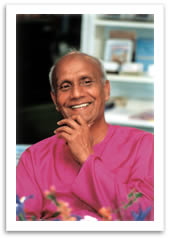
Sri Chinmoy (27 August 1931 – 11 October 2007) is a spiritual teacher who created several initiatives to cultivate peace and world harmony. A prolific poet, artist, athlete and musician, he stated his creativity and artistic expressions which came from an inner life of prayer and meditation. His teachings emphasise love for God, daily meditation on the heart, service to the world, and religious tolerance rooted in the view that all faiths are essentially divine. He often described himself as a “student of peace”.
Chinmoy Kumar Ghose was born on 27 August 1931 in the village of Shakpura, Chittagong in East Bengal. (Chittagong district was then part of India, it is now part of Bangladesh.)
His father, Shashi Kumar Ghose, worked as a ticket inspector, and later set up his own bank. His mother was Yogamaya Ghose. Chinmoy was the youngest child of seven siblings. His brothers were Hriday, Chitta and Mantu; his sisters were Lily, Ahana and Arpita. The meaning of Chinmoy is “One who is full of Divine Consciousness all-pervading”.
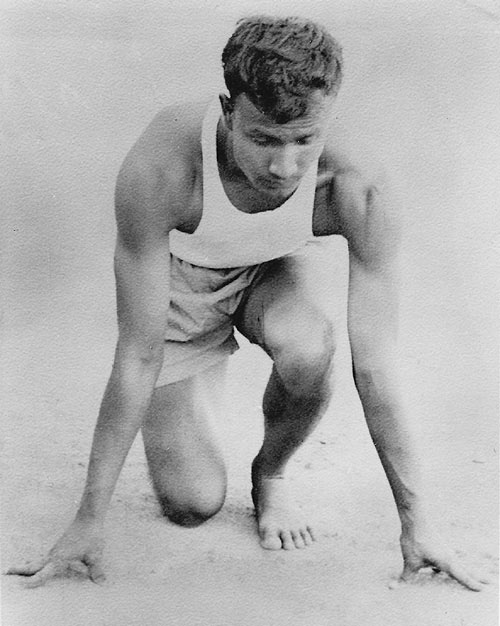
In 1944, a few months after the passing of both his father and mother, his whole family moved to the Sri Aurobindo Ashram in the south of India where they were accepted as permanent members. In the Sri Aurobindo Ashram, the young Chinmoy worked at various jobs, from book-binding to washing dishes. He also cultivated an interest in athletics. He was an excellent sprinter, winning the ashram championship for 16 consecutive years. He was also a decathlon champion in 1958 and 1959.
In the ashram, Chinmoy also began an intense period of meditation. He would wake up at 2.07 a.m. to begin meditating. He would meditate for many hours, in addition to his work and practice of athletics. By virtue of his deep meditation, he had many profound spiritual experiences, which he later recalled.
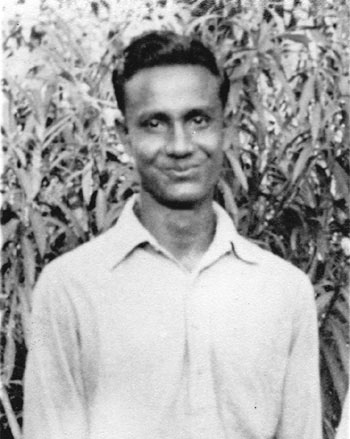
In the ashram, he also cultivated his interest in poetry, writing in both English and Bengali. In 1946, he translated Sri Aurobindo’s Bengali story Kshamar Adarsha into 200 lines of Bengali verse. In 1958, he was appointed secretary to Nolini Kanta Gupta and was responsible for organising his papers and also translating his Bengali writings into English. Chinmoy would have been content to stay in the ashram, spending much of his time in meditation and samadhi. But, in the early 1960s, he felt from his meditation an inner prompting to travel to America and offer the wisdom of Eastern spirituality to Western seekers.
With the support of sponsors in the US, on 12 April 1964, Chinmoy left India to arrive in JFK airport on 13 April 1964.
On arrival in New York, Chinmoy found work at the Indian Consulate, under LL Mehrotra, where he spent two years working at the passport and visa section. This job enabled him to receive a US green card. Despite surviving on meagre financial resources, he recalled fondly his time there in a book My Consulate Years.
On 27th August 1965, he began publishing the monthly AUM magazine – which was a collection of articles, aphorisms, poems and songs composed by Sri Chinmoy. On receiving a copy of AUM magazine, on 10 November 1965 the then President of India, Dr S Radhakrishnan sent a message of congratulations for the spiritual vision of the magazine.
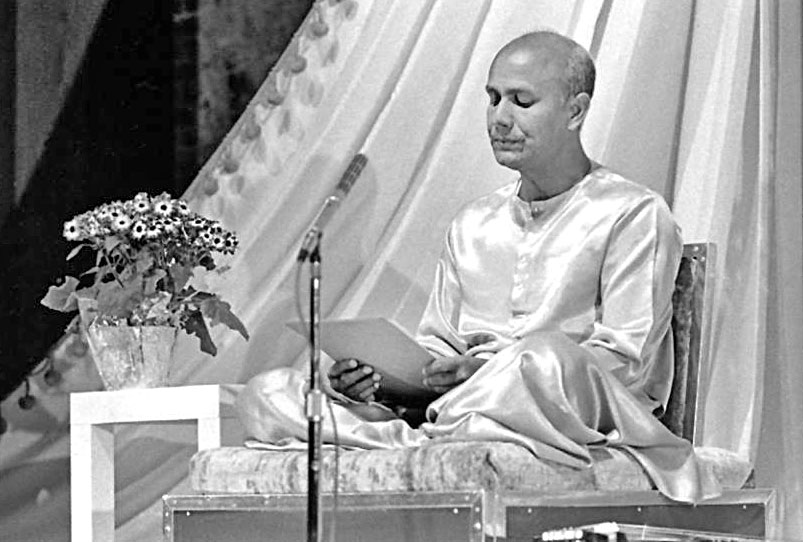
During these early years, Chinmoy also gave his first lectures and musical performances and started to attract a small group of devotees. By 1966, he was able to retire from the Indian Consulate and devote himself full time to his spiritual mission. In 1966, he established his first spiritual Centre (then called the “AUM Centre”) in Puerto Rico. Shortly after he established a Centre in New York. There are now Sri Chinmoy Centres in approximately 50 countries worldwide.
Between 1968 and 1970, Sri Chinmoy gave talks at American universities, such as Yale, Harvard and Cornell. Later in 1970, he made his first European tour, giving lectures at different European universities, including Oxford and Cambridge. Throughout the 1970s, he also travelled widely around the world giving further lectures in Canada, Japan, the Far East and Central America. These lectures were on aspects of spirituality and spiritual philosophy – they have been collected in three volumes of The Oneness of the Eastern Heart and the Western Mind.
In the early 1970s, Sri Chinmoy moved into a modest detached house in Briarswood, Queens, New York where he lived until his mahasamadhi in 2007. His students continue to run several enterprises in the neighbourhood and continue his teachings and meditation Centres.
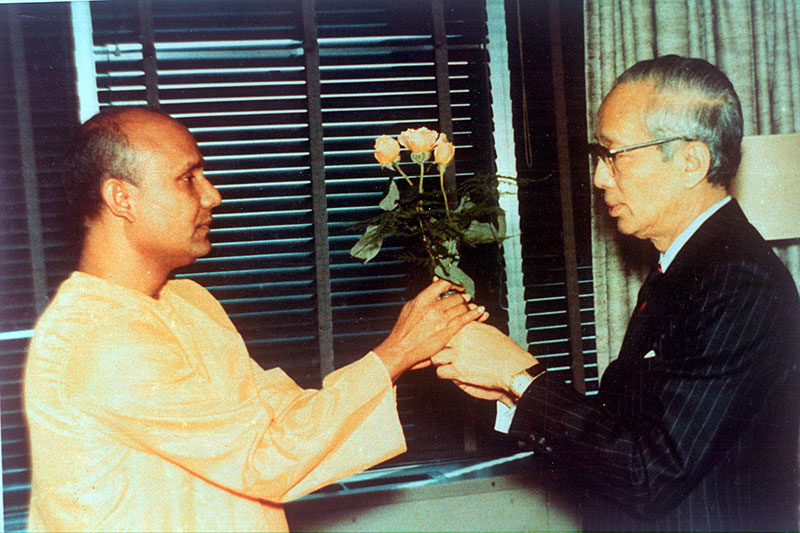
In April 1970, at the invitation of the then UN Secretary General U Thant, Sri Chinmoy began conducting “Peace Meditations at the United Nations”, an NGO holding non-denominational services open to UN delegates and staff.
“Whoever speaks to me about you is all appreciation and admiration, and I personally feel that you have been doing a most significant task for the United Nations. Please feel my sincere respect and sincere concern for what you are doing for mankind.”
Secretary-General U Thant 1
Sri Chinmoy served at the United Nations for the next 37 years, offering meditations, peace walks, lectures and meetings with staff and ambassadors.
Throughout his life, Sri Chinmoy remained a staunch supporter of the ideals of the United Nations, believing that the UN had the capacity to be an instrument for universal oneness between people from across the world.
“The United Nations is humanity’s home. The lofty vision of the United Nations is that we all belong to a peace-loving oneness-world-family. This vision will eventually transform the face and fate of the world.”
Sri Chinmoy 2
In 1995, he commemorated the 50th anniversary of the UN with a concert, held in the General Assembly Hall lobby, in which he performed on 50 instruments. He also offered a total of 50 Peace Concerts that year for the United Nations.
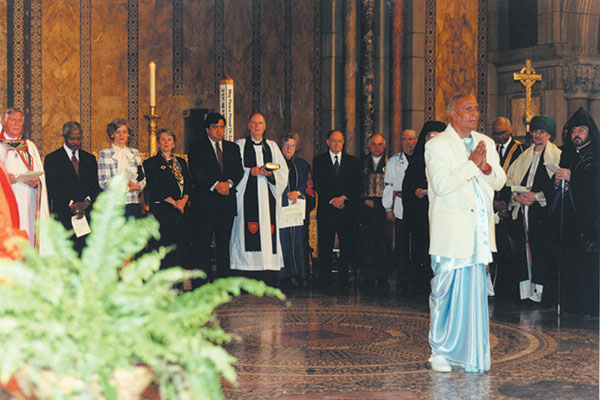
Sri Chinmoy believed in the underlying unity of the different world religions. To support the ideal of religious tolerance and religious unity, Sri Chinmoy participated in several Interfaith activities, and often spoke about the shared spiritual values of different religions.
“If we live in our oneness-heart, we will feel the essence of all religions which is the love of God. Forgiveness, compassion, tolerance, brotherhood and the feeling of oneness are the signs of a true religion.”
Sri Chinmoy 3
In July 1975, Sri Chinmoy offered the opening meditation at the National Day of Prayer ceremony at the UN, and at a similar ceremony in April 1976. Sri Chinmoy participated in many interfaith initiatives during his time in the West. His philosophy is to see the underlying oneness of different religions.
“Yes, I believe in one God, one Source. Love of God is like a tree – the life-tree – and it has many branches. Each of the branches has its own identity and its own name, such as Christianity, Buddhism, Hinduism, Judaism, Islam and so forth. But they are still branches of the same tree.”
Sri Chinmoy 4
In 1993, he was invited to Chicago to open the Parliament of the World’s Religions’ first plenary session with a silent meditation. 1993 was a significant year because it marked the centenary anniversary of Swami Vivekananda’s appearance at the 1893 Parliament (widely considered to be the birth of the modern interfaith movement). That year, Sri Chinmoy offered 39 Peace Concerts in honour of his fellow Indian, Swami Vivekananda.
Playing this video will load cookies from Vimeo. Please accept cookies to view this content.
In 2004, Sri Chinmoy was also invited to offer the opening meditation at the World Parliament of Religions in Barcelona.
Sri Chinmoy wrote poetry throughout his life. His poetry expresses different aspects of spiritual experience – from the bliss of Nirvana ('The Absolute',) to the struggles of a spiritual seeker, where he identifies with the striving to overcome bondage and limitation.
“A sea of Peace and Joy and Light Beyond my reach I know. In me the storm-tossed weeping night Finds room to rage and flow…”5
Sri Chinmoy – from 'The Golden Flute'
Towards the end of his life, Sri Chinmoy concentrated on shorter, haiku like aphorisms, which serve as instructional teachings for those seeking a deeper meaning to life. Sri Chinmoy was remarkably prolific, producing over 70,000 poems – including major poetry series, such as Ten Thousand Flower Flames and Seventy-Seven Thousand Service Trees.
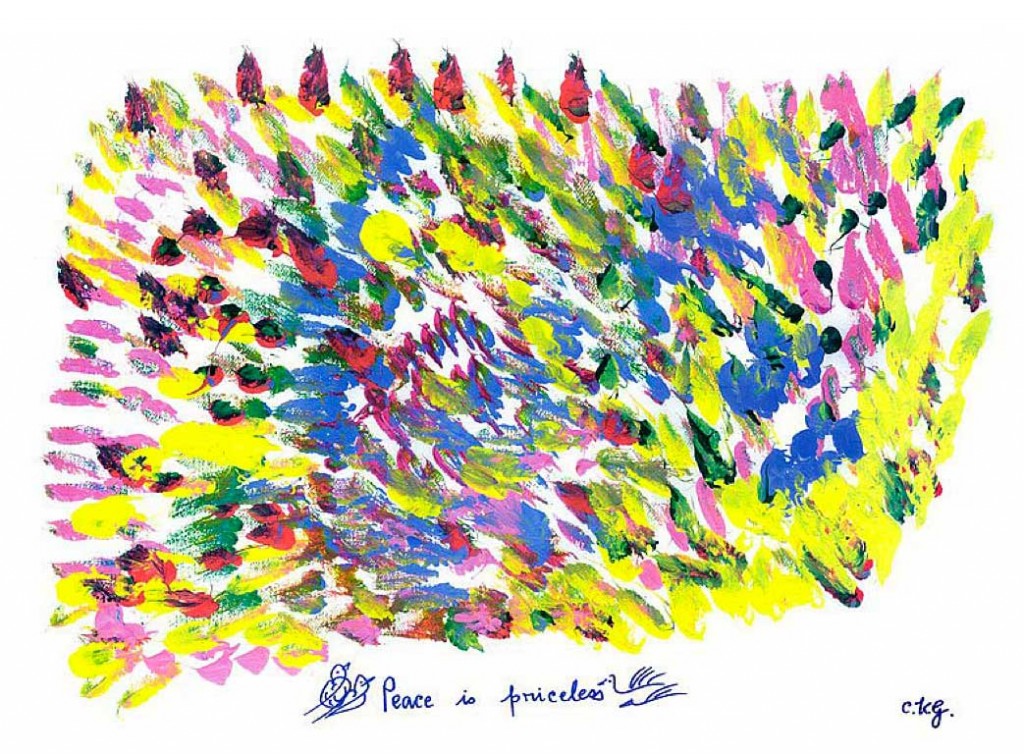
Sri Chinmoy began painting on 19 November 1974, whilst staying in Ottawa, Canada. He had no formal training in art but he soon developed his own unique and spontaneous style, which he termed “Jharna-Kala” or “Fountain Art”. The format of his art ranged from small pen drawings to colourful abstract acrylics on large canvas. His artworks are a fusion of vibrant colours, unconstrained by any convention or formal school. To Sri Chinmoy, the purpose of art is to express the soul’s world in a way that offers fresh inspiration to humanity. When painting, Sri Chinmoy says he enters into a meditative consciousness. He does not use his mind or think about what to paint.
“Usually when I draw, I try to be in a contemplative mood – in a prayerful, soulful consciousness – and I do not talk.”
Sri Chinmoy 6
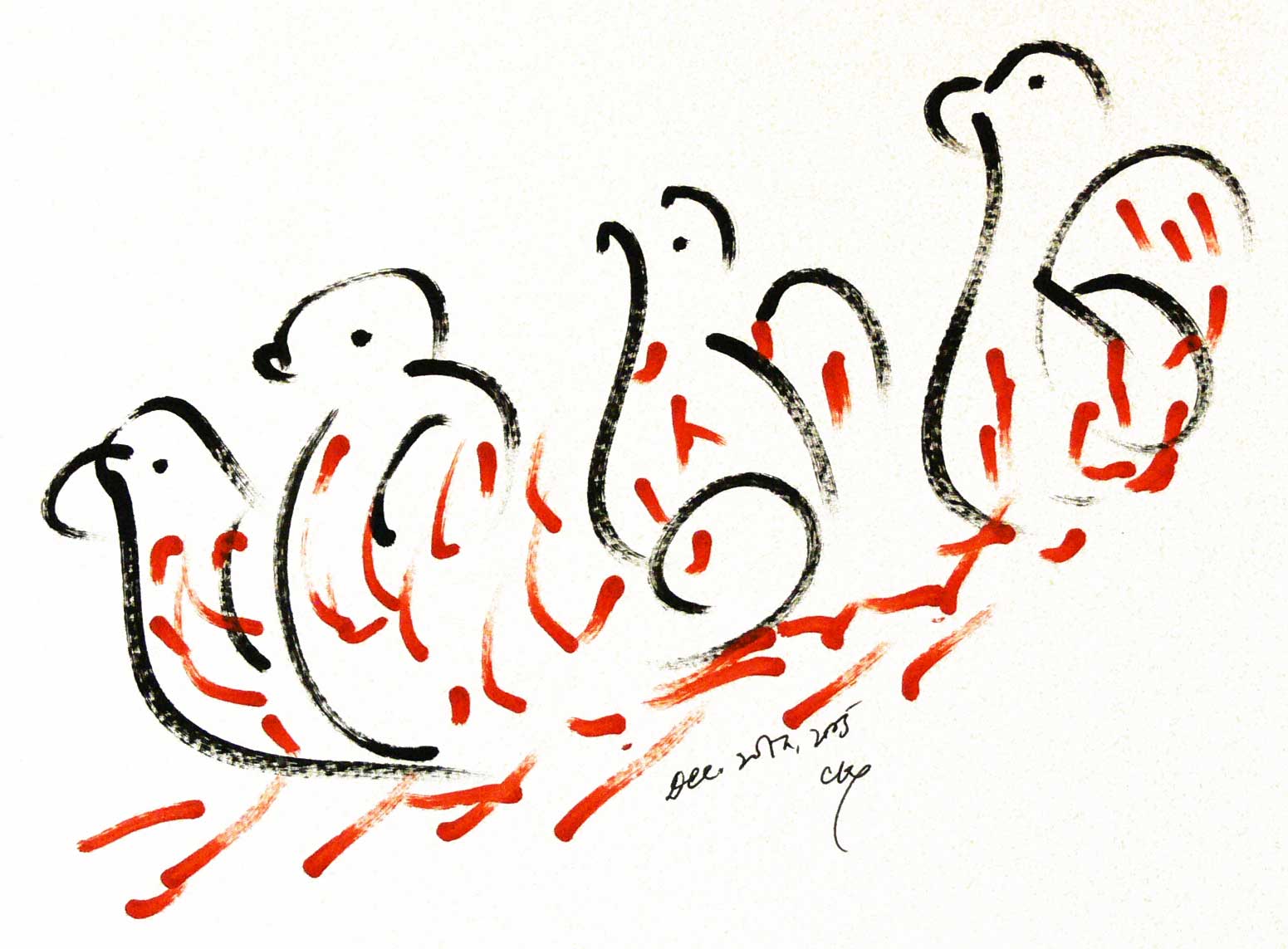
In Malta, 1991, Sri Chinmoy embarked on a new artistic journey when he began painting “Soul-Birds”. To Sri Chinmoy these simple, free-form drawings of birds encapsulate the freedom and aspiration of the soul. Over the next 16 years, Sri Chinmoy drew over 15 million of these birds on a variety of different media and formats. He often appended soul-birds to his signature when signing cards.
“These birds represent unity in multiplicity. Here we have 70,000 birds. Each bird is different, but when you look at them, you feel unity. As soon as we think of the bird-consciousness, it is one. The bird-consciousness represents the consciousness of our soul’s inner freedom.”
Sri Chinmoy 7
Sri Chinmoy’s artworks have been exhibited in over 20 countries around the world, in galleries such as the Caroussel du Louvre in Paris, and distinguished buildings such as the United Nations Secretariat in New York and the parliament buildings of the United States, Australia, New Zealand and the Ukraine. In presenting Sri Chinmoy with an award from Manhattan’s School of Visual Arts in June 1976, the late Brian Gormley described his work as “art cleansed of all the ambitions and desires that we too often see in the art world”.
Sri Chinmoy wrote from an early age, and after moving to the West in 1964, began publishing. In total, Sri Chinmoy had 1,573 books published during his lifetime, many published by Agni Press, a publishing company associated with the Sri Chinmoy Centre.
This collection of works includes: Sri Chinmoy’s talks, questions and answers, stories and light-hearted works. His works also encompass commentaries on sacred texts, several volumes of poetry, and plays about great spiritual Masters, such as the Buddha and Sri Aurobindo.
Books published to a wider audience include: Meditations: food for the soul (1970, Harper & Row), Yoga and the Spiritual Life (Tower Publications), and Songs of the Soul (Herder & Herder). In recent years, best-selling books include: The Wings of Joy (1997, Simon & Schuster – on its ninth edition) and The Jewels of Happiness (2014) published by Watkins.
Sri Chinmoy was a prolific composer of songs in Bengali and English; in total, he composed 22,000 songs. In many cases the songs were originally poems, which Sri Chinmoy later set to music. They have been performed in numerous styles from simple accapella singing to more complex arrangements including classical and modern styles. Sri Chinmoy’s songs and poetry are an important aspect of his devotional approach to spirituality and many of his students learn his songs as a way to create a devotional atmosphere.
Playing this video will load cookies from Vimeo. Please accept cookies to view this content.
Sri Chinmoy recorded his first album in the 1960s on vinyl. Many of his early albums featured Sri Chinmoy singing his Bengali compositions accompanied by the harmonium, for example: Mother I bow to Thee (at Radio Sri Chinmoy). He later took up other instruments, in particular the esraj, flute, cello, piano and organ. His favourite instrument was the esraj and he would typically play this in any concert.
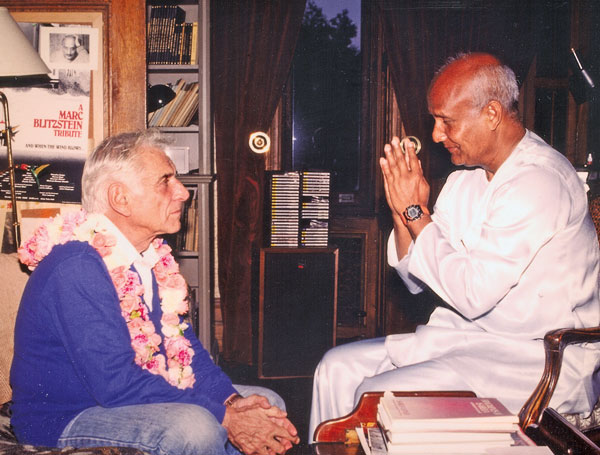
Sri Chinmoy met several distinguished musicians, including Pablo Casals, Leonard Bernstein and Yehudi Menuhin. In Sri Chinmoy, Leonard Bernstein found a kindred musical spirit.
“You are a miraculous model of the abundance in the creative life that we lesser mortals seek, and I can only hope that I may some day meet you and perhaps participate in that cosmic fountain of stillness and profound energy which you inhabit.”
Leonard Bernstein 8
Playing this video will load cookies from Vimeo. Please accept cookies to view this content.
In 1984, Sri Chinmoy began a series of “Peace Concerts”. The first concert was held in Cologne, Germany and attracted an audience of 7,000. For the next 23 years, Sri Chinmoy travelled around the world, giving a total of 777 concerts at venues such as London’s Royal Albert Hall, New York’s Carnegie Hall, Tokyo’s Nippon Budokan, and the Sydney Opera House. In these later years, Sri Chinmoy gave fewer public lecturers, feeling that these concerts were more productive in offering a meditative experience. Sri Chinmoy did not charge for his concerts, wishing his public service to be available for free, in the Indian tradition of spirituality.
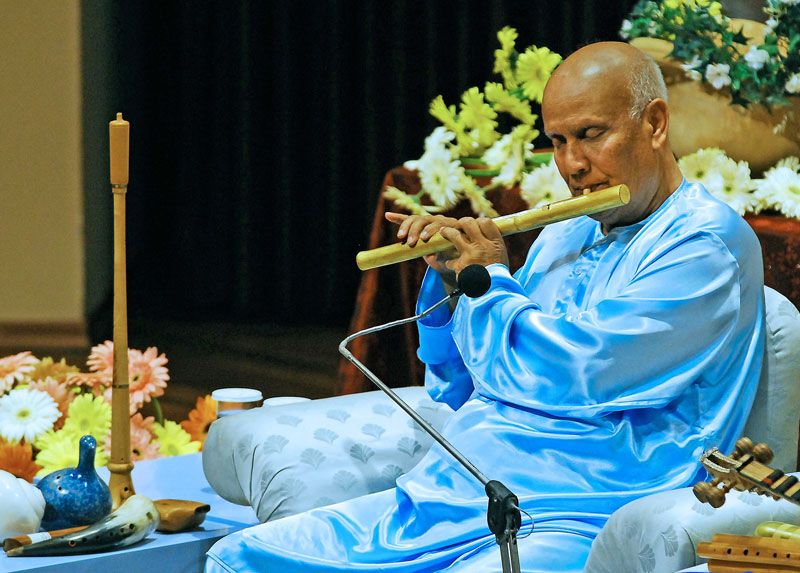
Sri Chinmoy’s music is simple, spontaneous, and appeals to a childlike spirit. He typically alternates between peaceful melodies played on the Western flute or Indian esraj, and also lively extemporaneous performances on the synthesizer, piano and organ. Sri Chinmoy also liked to experiment and try new instruments, teaching himself how to play. He often finished a concert with piano, organ or sympathiser improvisation.
Sri Chinmoy composed songs spontaneously, without writing a musical score. His melody and words were transcribed by students. His music results in irregular barlines or mixed metre. When performing his own compositions, each performance often resulted in slightly different versions. To Sri Chinmoy, soufulness is more important than sticking to the exact score.
His music has been arranged by a variety of performers – both from within the Sri Chinmoy Centre and classical musicians, such as Bannya Reswana Choudary, Heinrich Schweizer and Boris Purushottama Grebenshikov.
“Music is psychic enlightenment. Music is the supreme fulfilment of the aspiring human soul.”
Sri Chinmoy 9
His emphasis on poetry and song may be best viewed in the tradition of Bhakti (devotional) yoga. In this spiritual tradition, music and poetry help to bring the aspiration of the heart and soul to the fore – and help overcome the dryness of the mind.
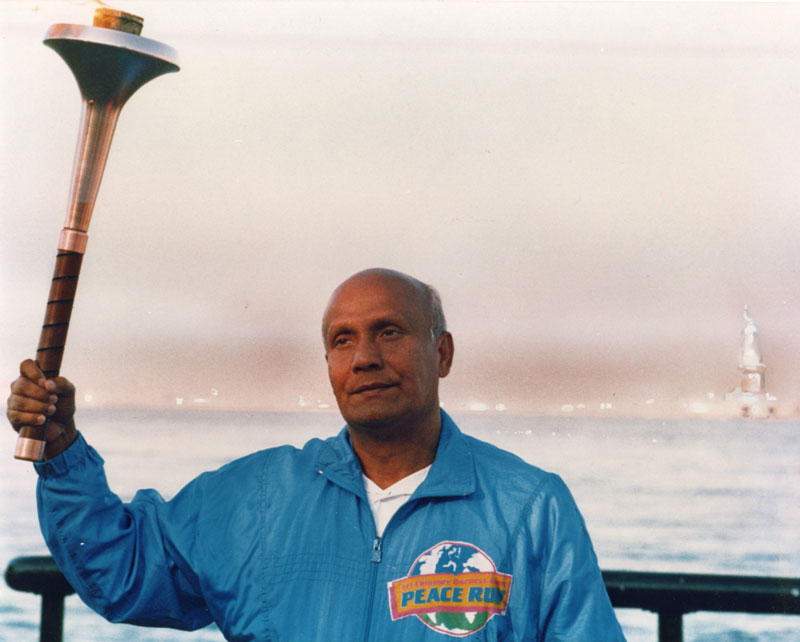
The Sri Chinmoy Oneness-Home Peace Run was founded in 1987, as a dynamic initiative to nurture and share humanity’s universal aspiration for peace.
Its precursor was the 1976 Liberty Torch Run, a relay in which 33 runners marked America’s bicentennial by covering 8,800 miles in 7 weeks, mapped out over 50 states. The run began and ended in New York City, and was met on its final leg by then Mayor Abraham Beame, who proclaimed 16 August 1976, “Liberty Torch Day”.
This concept was expanded in 1987 to become the international Peace Run – generally held every two years. The run does not fundraise or highlight any political cause. The aim of the Run is to raise world consciousness about the need for peace and give people from all countries and backgrounds the opportunity to take part. The motto of the Peace Run is “Peace begins with me”.
Since its inception in 1987, the run has traversed over 150 nations, and touched the lives of millions of people. It is estimated that the Peace Torch has been carried over 400,000 miles (632,000 km).
During the past three decades, the Peace Run has also met innumerable schools, community groups and community ambassadors. The Peace Torch has been held by global figures, such as Pope John Paul II, Pope Francis, Dr Davidson Hepburn, and Nobel laureates, such as Mother Teresa and Rigoberta Menchu. It has received support from community leaders and schools who have seen the Peace Run as a vehicle to help emphasise the importance of peace, harmony and respect for diversity.
Sri Chinmoy entered running races from his youth until his sixties. In his ashram days in India, he primarily concentrated on sprinting and the decathlon. In the late 1970s, he embarked on a long distance running career, which included 21 marathons and five ultra-marathons. His best time for the marathon was 3.55.07 in Toledo, Ohio.
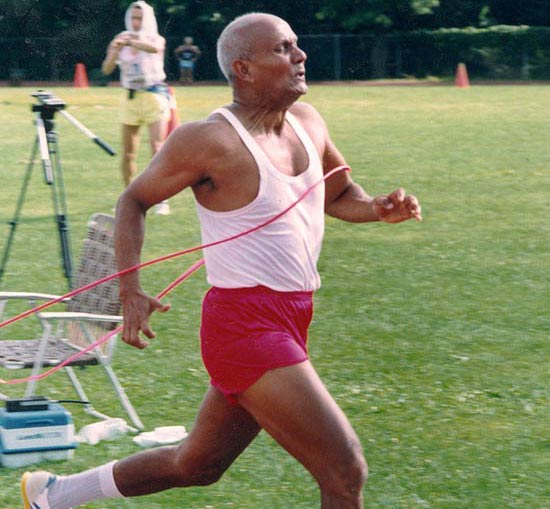
Where injuries allowed he continued to participate in athletic meetings into his 60s and 70s. He participated in the World Masters Games in San Juan, 1983, where he ran the 400-metres in 72.66 seconds. In 1983 (at age 52), he ran the 400-metre dash in 72.66 seconds at the World Masters Games in San Juan, Puerto Rico. At age 49, he ran the 47-mile Sri Chinmoy Ultramarathon in 11:27:24 in Queens, New York. An important part of Sri Chinmoy’s philosophy was to transcend the barriers of age.
“Age is no barrier. I find that the mind makes us feel we are very old. The moment I use my heart, I am 20 years old again. When we experience deep meditation, we see that spiritual energy is the source of physical, vital and mental energy.”
Sri Chinmoy 10
In 1977 he founded the Sri Chinmoy Marathon Team, which holds running, swimming, and cycling events worldwide. These events range from local two-mile races to marathons and ultra marathons. Sri Chinmoy also played a key role in the growth of the ultra-distance and multi-day running. For many years the 700-, 1000- and 1,300-mile ultras were one of the leading ultra events in the US, and ultra-legends, such as Yiannis Kouros and Al Howie, set new world records in these events. Interviewed by Sports Illustrated in 1990, multiple World Record Holder, Yiannis Kouros said: “Without Sri Chinmoy, we would have few races and little future. He has been the sport’s lifeline.” In 1997, Sri Chinmoy also founded the 3100 Mile Self Transcendence Race – the longest certified footrace in the world.
Sri Chinmoy met many athletes throughout his life, including his childhood hero Jesse Owens, Carl Lewis, Emil Zatopek and Paula Radcliffe. In 1978, he received a distinguished service award from Runner’s World magazine “for dedicated service to humanity through the promotion of running”.
Many of Sri Chinmoy’s followers run daily for health and fitness. A few, like Suprabha Beckjord, Dipali Cunningham and Asprihanal Aalto are respected ultra-marathoners with age and distance related world records. The Sri Chinmoy Marathon Team also has over 40 individual Channel Swims and ranks second as the club with the most successful crossings.
Playing this video will load cookies from Vimeo. Please accept cookies to view this content.
In 1985, Sri Chinmoy took up weightlifting, an activity he had previously had little interest in. Part of the reason was a knee injury which hampered his running, but he also took up the sport because of an inner inspiration to enter this new field. From the age of 54 to 76, Sri Chinmoy made rapid progress in weightlifting and often surprised the weightlifting community with his progress and capacity. Sri Chinmoy said his motivation for weightlifting was to “inspire humanity” and show that age need not be a barrier to progress.
On 2 November 1998, after an exhibition in Teterboro, New Jersey in which he lifted six light aircraft in sequence, he was asked by The Bergen Record, “Why do you do this?” He replied:
“I am trying, according to my humble capacity, to be of dedicated service to the world…. All this I am doing to inspire others. … Inspiration is a divine element inside our life. When we are inspired, we try to climb up the Himalayas. When we are inspired, we try to swim the English Channel. When we are inspired, we go from one country to another country to inspire people and to be inspired by them. I feel that when we inspire humanity, we automatically become good citizens of the world. This is my philosophy. My weightlifting feats I have done solely to inspire humanity.”
Sri Chinmoy 11
Sri Chinmoy says the strength for his lifting comes from the inner power, and that he depends on “God’s Grace”.
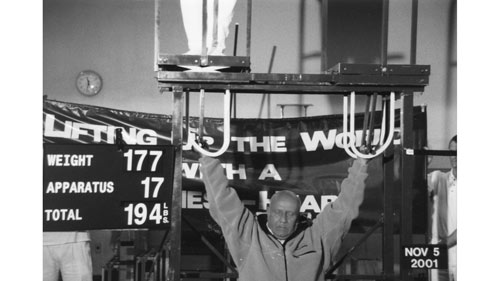
Sri Chinmoy also used his weightlifting to acknowledge men and women around the world who were of inspiration to their communities and the world. From 1988 to 2007, Sri Chinmoy inaugurated an award programme called Lifting up the World with a Oneness-Heart. In this programme he honoured individuals by raising them overhead using a specially constructed overhead platform. During this period, over 8,000 people were honoured by Sri Chinmoy in this way, including Nelson Mandela, Muhammad Ali, Desmond Tutu, marathon champions Paul Tergat, Paula Radcliffe and Tegla Laroupe and the heads of state of over ten countries. As well as lifting dignitaries, sports stars and religious leaders of all faiths, Sri Chinmoy also lifted people from ordinary walks of life, who contributed to creating a better world –- pilots, nurses, firemen, university professors, police and others.
Sri Chinmoy has called his teaching the “Path of the heart” and also the path of “Love, devotion and surrender”.
“To me the path of the heart means divine love, divine devotion and divine surrender.”
Sri Chinmoy 12
It is a spiritual path, which emphasises bhakti yoga (path of devotion) but also encompasses karma yoga (selfless service) and jnana yoga (yoga of wisdom) – which includes meditation and spiritual knowledge.
In a broad sense it is an integral path, encompassing several branches of spiritual activity; Sri Chinmoy firmly advocates his disciples to accept and live in the world, eschewing the older Indian tradition of retreating from the world.
To his followers, Sri Chinmoy advises a balanced life of prayer, meditation, selfless service and physical fitness. He asks his disciples to refrain from drugs, alcohol, adopt a vegetarian diet and a modest brahmacharya lifestyle. Sri Chinmoy did not charge a monetary fee for those wishing to follow his path, but said the real fee was the inner cry and aspiration. On the spiritual path, he describes the role of a Guru or Spiritual Teacher as an elder brother in the family.
“Guru is a Sanskrit word which means “he who illumines”. The one who offers illumination is called a Guru. According to my own inner realisation I wish to say that there is only one real Guru, and that is the Supreme.”
Sri Chinmoy 13
Sri Chinmoy also taught that the real guidance of a spiritual Guru occurs in silence. By meditating on the soul of the seeker, the Guru tries to bring forward the inner light of the disciple’s own soul.
Sri Chinmoy did not wish to start a religion. He said he only offered a spiritual path, in the tradition of yoga. Yoga is a Sanskrit word which means “Union with God”. To Sri Chinmoy, many paths can lead to this same goal of union with God. There is no conflict with different spiritual paths and religions, but each seeker must choose the path that suits him best. Although Sri Chinmoy is of a Hindu background, the path is universalist in outlook, and followers are welcome to follow their own religion or none.
“Yoga does not interfere with any religion. Anybody can practise Yoga. I have disciples who are Catholics, Protestants, Jews and so forth. One can practise Yoga irrespective of religion. … The real aspirant who has launched into spirituality and Yoga will find no difficulty in remaining in his own religion. I tell my disciples not to give up their own religion.”
Sri Chinmoy 14
On a few occassions, Sri Chinmoy remarked his only religion was love of God. Sri Chinmoy describes God as including both form and the formless, and both Father and Mother aspects.
“God is infinite Consciousness, infinite Bliss, yet he can also assume a finite form. He is infinite, He is finite; and at the same time He transcends both the infinite and the finite.”
Sri Chinmoy 15
When talking about God, he often prefers the term Supreme, to represent the ever-transcending reality. He also describes God as inner Truth, and as one’s most illumined part. The aim of yoga is for a seeker to become aware of the “God within”.
Sri Chinmoy entered mahasamadhi on the morning of 11 October 2007, at his home in Briarwood, New York. A few days prior he had been on a trip to St. Petersburg, Russia, where he performed a small concert and took part in the dedication of a children’s hospital. On the prior evening of 10 October 2007 he had conducted a regular meditation gathering at Aspiration-Ground.
The final poem in the last poetry book sold by Sri Chinmoy – just a few days previously – My Christmas-New Year-Vacation Aspiration-Prayers, part 52 was:
“My physical death Is not the end of my life – I am an eternal journey.”
Sri Chinmoy 16
This short poem encapsulates Sri Chinmoy’s philosophy that death is not the end, but a transition from the physical world to the world beyond.
A memorial service was held at Aspiration-Ground on Sunday, 14 October 2007. Also, on 30 October 2007, there was a large celebration at the United Nations commemorating his life and work.
A selection of awards and recognition conferred on Sri Chinmoy during his lifetime.
Pilgrim of Peace Award. (Pellegrino di Pace) Presented by: Centro Internazionale Per la Pace Fra I Popoli. 16 May 1998, Galleria Palazzo Colonna, Roma.
The Gold Papal Seals. Presented by: Pope Paul VI, 22 March 1972 and 27 June 1973 for service to humanity.
Distinguished Service Award. Presented by: United Nations Association of America 1976, 1977.
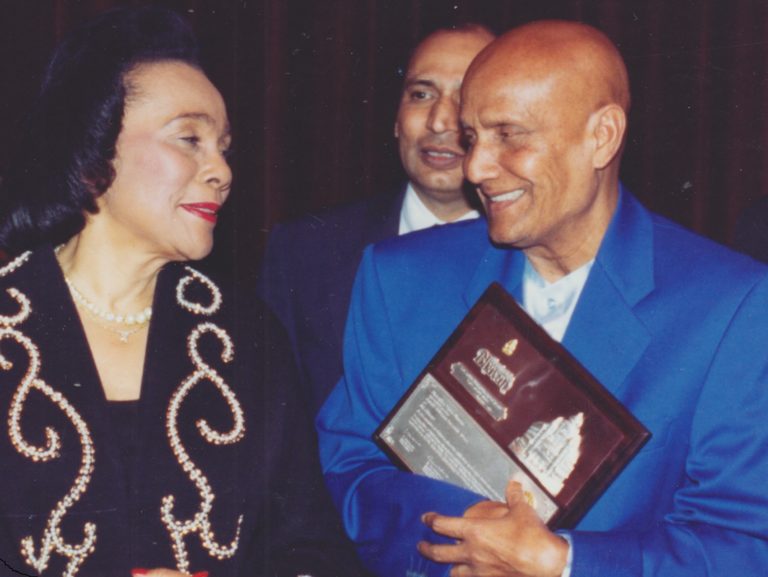
The Gandhi Universal Harmony Award. Presented by: Bhavan USA, 28 October 1994 – received jointly with Mrs Coretta Scott King.
United Nations Silver Medallion. Presented by: United Nations Secretary General Kurt Waldheim, 16 July 1976 – “In appreciation for Sri Chinmoy’s work at the United Nations and in recognition of his work for world peace.”
New York Marathon Medal. Presented by: Fred Lebow, President of the New York Road Runners Club, 1977.
Hindu of the Year Award. Presented by: Hinduism Today 1997.
Jesse Owens Humanitarian Award. Presented by: The Jesse Owens Foundation, 15 November 2002, Chicago.
U Thant, United Nations Headquarters, 29 February 1972. Kind words U Thant.↩︎
Sri Chinmoy, World-Destruction: Never, Impossible! Part 1, Agni Press, 1994.↩︎
World-Destruction: Never, Impossible! Part 1, Agni Press, 1994.↩︎
Sri Chinmoy, Sri Chinmoy answers, part 3, Agni Press, 1995.↩︎
Sri Chinmoy, Sri Chinmoy answers, part 36, Agni Press, 2004.↩︎
31 October 1977 Sri Chinmoy, Four Summit-Height-Melodies meet with Sri Chinmoy, Agni Press, 1995.↩︎
Sri Chinmoy, Sound and silence, part 2, Agni Press, 1982.↩︎
Weightlifting quote.↩︎
Sri Chinmoy, A mystic journey in the weightlifting world, part 1, Agni Press, 2000.↩︎
Sri Chinmoy, Sri Chinmoy answers, part 29, Agni Press, 2001.↩︎
Sri Chinmoy, Earth’s cry meets Heaven’s Smile, part 1, Agni Press, 1974.↩︎
Sri Chinmoy, The Vision of God’s Dawn, Agni Press, 1974.↩︎
Sri Chinmoy, My Christmas-New Year-Vacation Aspiration-Prayers, part 52, Agni Press, 2007.↩︎